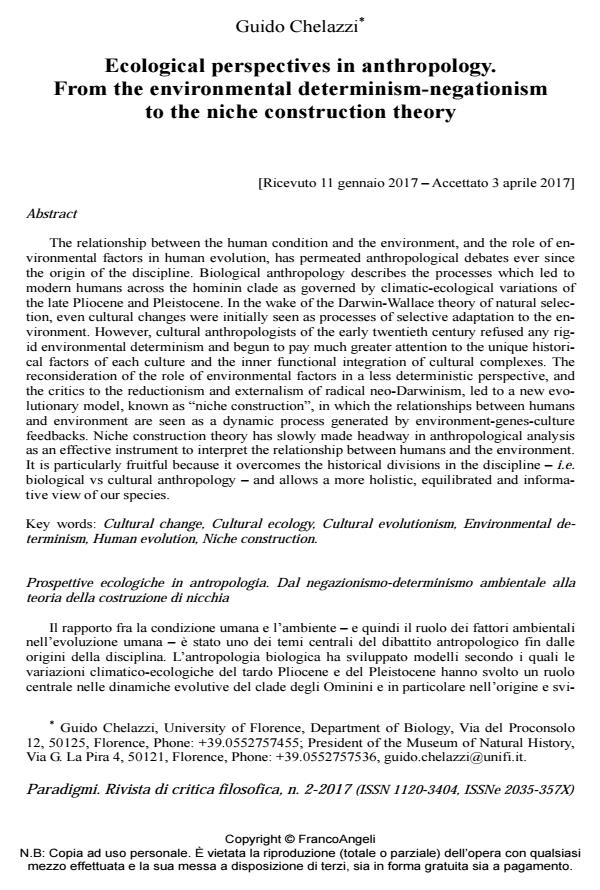Ecological perspectives in anthropology. From the environmental determinism-negationism to the niche construction theory
Journal title PARADIGMI
Author/s Guido Chelazzi
Publishing Year 2017 Issue 2017/2 Language English
Pages 17 P. 123-139 File size 187 KB
DOI 10.3280/PARA2017-002009
DOI is like a bar code for intellectual property: to have more infomation
click here
Below, you can see the article first page
If you want to buy this article in PDF format, you can do it, following the instructions to buy download credits

FrancoAngeli is member of Publishers International Linking Association, Inc (PILA), a not-for-profit association which run the CrossRef service enabling links to and from online scholarly content.
The relationship between the human condition and the environment, and the role of environmental factors in human evolution, has permeated anthropological debates ever since the origin of the discipline. Biological anthropology describes the processes which led to modern humans across the hominin clade as governed by climatic-ecological variations of the late Pliocene and Pleistocene. In the wake of the Darwin-Wallace theory of natural selection, even cultural changes were initially seen as processes of selective adaptation to the environment. However, cultural anthropologists of the early twentieth century refused any rigid environmental determinism and begun to pay much greater attention to the unique historical factors of each culture and the inner functional integration of cultural complexes. The reconsideration of the role of environmental factors in a less deterministic perspective, and the critics to the reductionism and externalism of radical neo-Darwinism, led to a new evolutionary model, known as "niche construction", in which the relationships between humans and environment are seen as a dynamic process generated by environment-genes-culture feedbacks. Niche construction theory has slowly made headway in anthropological analysis as an effective instrument to interpret the relationship between humans and the environment. It is particularly fruitful because it overcomes the historical divisions in the discipline - i.e. biological vs cultural anthropology ? and allows a more holistic, equilibrated and informative view of our species.�
Keywords: Cultural change, Cultural ecology, Cultural evolutionism, Environmental determinism, Human evolution, Niche construction.
- Bar-Yosef O. (2011). Climatic Fluctuations and Early Farming in West and East Asia. Current Anthropology, 52: 175-193, DOI: 10.1086/659784
- Behrensmeyer A.K. (2006). Atmosphere: Climate Change and Human Evolution. Science, 311: 476-478,
- Belfer-Cohen A. and Goring-Morris A.N. (2011). Becoming Farmers: the Inside History. Current Anthropology, 52: 209-220, DOI: 10.1086/658861
- Boas F. (1965). The Mind of Primitive Man. New York: The Free Press (first edition The Macmillan Company 1911).
- Davidson I. (2013). Peopling the Last New Worlds: the First Colonization of Sahul and the Americas. Quaternary International, 285: 1-29, doi 10.1016/jquaint. 2012.09.023.
- D’Errico F. (2003). The Invisible Frontier. A Multispecies Model for the Origin of Behavioral Modernity. Evolutionary Anthropology, 12: 188-202,
- Dunbar R.I.M. (1993). Coevolution and Neocortical Size, Group Size and Language in Humans. Behavioral Brain Sciences, 16: 681-735,
- Forde C.D. (1949). Habitat, Economy and Society. London: Methuen and Co.
- Kaplan D. and Manners R.A. (1972). Culture Theory. Foundations of Modern Anthropology Series, ed. by D. Marshall Sahlins. Englewood Cliffs: Prentice Hall Inc.
- Kendal J., Tehrani J.J. and Odling-Smee J. (2011). Human Niche Construction in Interdisciplinary Focus. Philosophical Transactions of the Royal Society B, 366: 785-792,
- Laland K.N. and O’Brien M.J. (2010). Niche Construction Theory and Archaeology. Journal of Archaeological Method and Theory, 17: 303-322,
- Laland K.N., Odling-Smee J. and Feldman M.W. (2001). Cultural Niche Construction and Human Evolution. Journal of Evolutionary Biology, 14: 22-33,
- Laland K.N. and Sterelny K. (2006). Perspectives: Seven Reasons (not) to Neglect Niche Construction. Evolution, 60: 1751-1762, DOI: 10.1554/05-570.1
- Lévi-Strauss C. (2002). Razza e storia. Razza e cultura. Torino: Einaudi (Original edition: Race et histoire. Race et culture, 2001 (UNESCO ed.).
- Lewontin R.C. (1983). Gene, Organism, and Environment. In: Bendall D.S., ed., Evolution from Molecules to Men. Cambridge: Cambridge University Press: 273-285.
- Liseev I.K. (2008). Philosophy of Nature Today. Dialogue and Universalism, 18: 123-131, 135,
- McBrearty S. and Brooks A.S. (2000). The Revolution that Wasn’t: a New Interpretation of the Origin of Modern Human Behaviour. Journal of Human Evolution, 39: 453-563,
- Noble D. (2015). Evolution beyond Neo-Darwinism: a New Conceptual Frame-work. Journal of Experimental Biology, 218: 7-13,
- Potts R. (2007). Paleoclimate and Human Evolution. Evolutionary Anthropology, 16: 1-3,
- Richerson P.J., Boyd R. and Henrich J. (2010). Gene-Culture Coevolution in the Age of Genomics. Proceedings of the National Academy of Sciences USA, 107: 8985-8992,
- Rowlands M. (2009). The Extended Mind. Zygon, 44: 628-641,
- Smith B.D. (2016). Neo-Darwinism, Niche Construction Theory, and the Initial Domestication of Plants and Animals. Evolutionary Ecology, 30: 307-324,
- Sterelny K. (2011). From Hominins to Humans: How Sapiens Became Behaviourally Modern. Philosophical Transactions of the Royal Society B, 666: 809-822,
- Sterelny K. and Watkins T. (2015). Neolithization in Southwest Asia in a Context of Niche Construction Theory. Cambridge Archaeological Journal, 25: 673-691, DOI: 10.1017/S0959774314000675
- Steward J.H. (1975). Theory of Culture Change. The Methodology of Multilinear Evolution. Urbana: University of Illinois Press. (First edition 1955, The Board of Trustees of the University of Illinois: USA Library of Congress Catalog 55-7372).
- Verhoeven M. (2004). Beyond Boundaries: Nature, Culture and a Holistic Approach to Domestication in the Levant. Journal of World Prehistory, 18: 179-282,
- Wallach E. (2016). Niche Construction Theory as an Explanatory Framework for Human Phenomena. Synthese, 193: 2595-2618,
- Walpoff M.F. (1971). Competitive Exclusion Among Lower Pleistocene Hominids. Man, New Series, 6: 601-614, DOI: 10.2307/2799185
- Zeder M. (2016). Domestication as a Model System for Niche Construction Theory. Evolutionary Ecology, 30: 325-348,
Guido Chelazzi, Ecological perspectives in anthropology. From the environmental determinism-negationism to the niche construction theory in "PARADIGMI" 2/2017, pp 123-139, DOI: 10.3280/PARA2017-002009